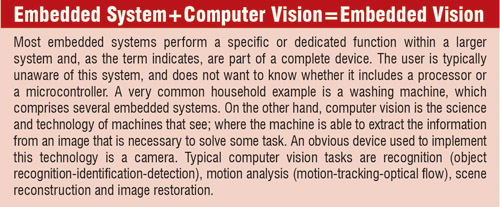
These systems either use a camera exclusively or, alternatively, may use camera and sensor technology. There could also be a variant of systems built to perform complex applications. Some systems currently use radar technology, whereas high-end systems complement a camera. Radar-based systems offer similar features with the addition of front- or rear-park assistance, forward collision warning, lane change assistance, blind spot detection, collision mitigation braking systems and full-speed range-adaptive cruise control.
Some systems also augment vision with radar and multiple sensors. Most systems available today are passive, that is, they only alert the driver. It is then really up to the driver to take action to avoid the hazard. Multiple manufacturers have started manufacturing and deploying active systems that automatically apply brakes to avoid a hazard. The key challenge with active systems is accuracy.

“With improvements in sensors, processors, algorithms and tools, it has become increasingly practical to incorporate visual intelligence into many kinds of systems, including systems with severe cost, size and power constraints,” says Jeff Bier, founder of Embedded Vision Alliance.
Different applications that use cameras and video analytics in an automobile
Using embedded vision technology, monitoring an object or something specific (like the lanes on the road) is made easy, since the vehicle could alert the driver. A camera could also be mounted and focussed on the driver, to detect if the driver is alert or not, is sleeping, texting or something like that.
“More generally, vision-based subsystems, enabled by the plummeting prices and escalating capabilities of image sensors, processors, memories and other devices, have the potential to enrich the capabilities of diverse system designs. These offer superior features like augmented reality or AR (superimposition of real images with signs), sleepiness detection, gesture-based control, facial recognition-based customisation, signboard recognition (such as speed signs), night vision and detection, video-based automatic parking, etc,” says Shenoy.
A lane departure warning system has been designed to warn a driver when the vehicle begins to move out of its lane (unless a turn signal is on, indicating the vehicle will turn in that direction) on free ways and high-capacity urban roads.
An automotive night-vision system increases drivers’ perception levels, enabling them to see a longer distance in the dark or in poor weather, beyond the reach of the vehicles’ headlights. These are currently offered to customers as optional equipment on certain premium vehicles.
Traffic sign recognition is a technology using which a vehicle is able to recognise the traffic signs on the road, such as speed limits, school-children crossings or a turn ahead. They first appeared in late 2008 on the redesigned BMW 7 series, and then on the Mercedes-Benz S class vehicles. Currently, these systems only detect the round speed-limit signs found all across Europe.
A collision avoidance system is a system of sensors that is placed within a car to warn its driver of any dangers that may lie ahead on the road.
“Many of the vision functions being incorporated or considered for automobiles—such as collision avoidance, AR, gesture user interfaces and gaze tracking—are applicable in many other types of systems, such as robotics, consumer electronics, education and healthcare,” says Bier.






